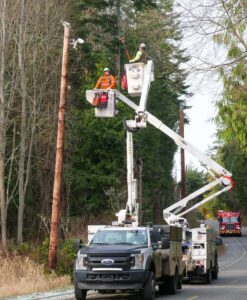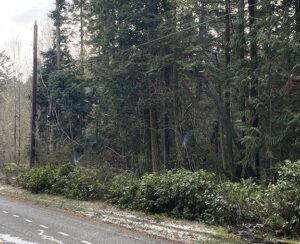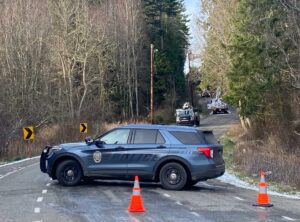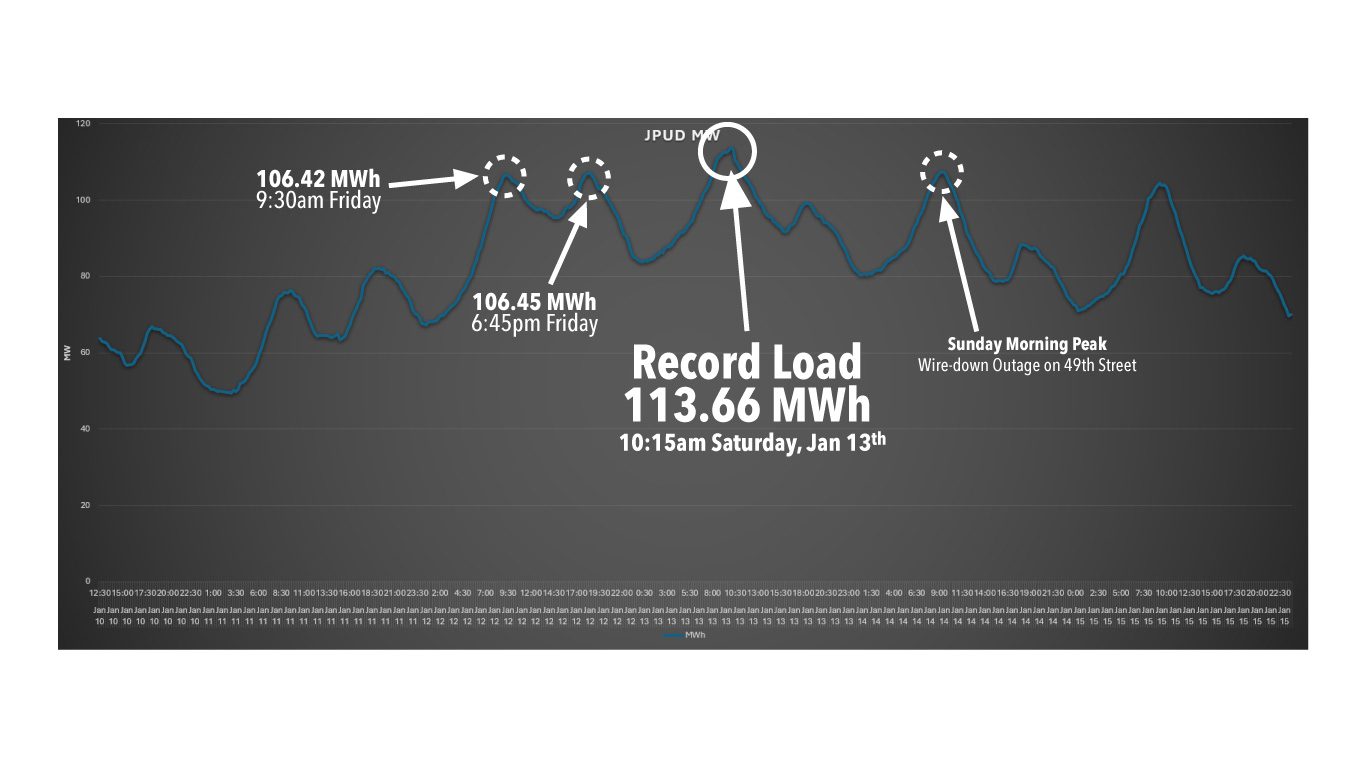Cold Weather Event Strains Portions of PUD Grid
Like many electric utilities across the US, Jefferson County PUD saw record demand for power during the recent cold event.

In Western Washington, demand for energy use is highest during the winter, often tripling the highest demands in summer. During the summer of 2023, demand spiked at 37 Megawatts (MWh). Peak demand Saturday morning January 13th was 113.66 MWh, the highest ever recorded for the PUD.
The lower the temperature outside, the more energy it takes to maintain a comfortable living temperature inside. Most Jefferson County homes are equipped to deal with 40-degree winter weather, a difference of only 28 degrees to maintain an average indoor temperature of 68. With temperatures in the low teens, home heating systems had to overcome a 50+ degree gap.
Uninsulated and poorly insulated homes with electric resistance heat (wall heaters, base board heat, etc.) likely saw their electricity use spike upwards while still shivering inside. In sub-20-degree weather even some insulated, efficient homes struggled to stay warm. Many homes with older or less expensive heat pumps (ideal for home heating 355 days of the year) had to turn on resistance wall heat or plug in space heaters to help compensate. It wasn’t until the last decade that many commonly available heat pumps were designed to handle very cold temperatures.
Staying warm in a poorly insulated house is difficult enough during a cold snap. It’s exponentially harder when the power goes out. Or, as it did for portions of the county, when power goes out repeatedly.
Though the total number of east Jefferson residents to lose power during the event was not high, portions of the PUD’s power grid struggled to keep customers connected during some of the lowest temperatures.

Port Towsend residents off of Cook Ave, 53rd street, 49th street, and tucked back along Seaview Drive were without power repeatedly throughout the weekend. South of the Hood Canal Bridge near South Point, similar issues occurred on Friday, though not as repeatedly nor for as long as in Port Townsend. On Saturday, more than half of Marrowstone island lost power without a single branch falling on wires.
As with any storm or weather event, the PUD’s line crew were on the scene as soon as the first outages occurred. They were out on the terrible roads Thursday night, all day Friday and into the evening as temps dropped to single digits in parts of the county. Crews remained out all day Saturday, and intermittently afterwards. They began their work Thursday with tree and branch removal, standard outage stuff, but as the cold increased, so did the level of difficulty in restoring customers.
If you look at the top of poles, you’ll see a strange d-shaped device between the transformer and the wires running above it. That d-shaped device is essentially a circuit breaker. It trips when there’s too much demand, or not enough capacity. And like the circuit breakers in a home electric panel, it trips to prevent damage from occurring. Damage like meltdowns, fires, or minor explosions. There are fuses of various sizes and shapes all over the PUD’s electric system, and PUD line crews are experts at quickly replacing them and restoring power.
But on Friday along Cook Ave in Port Townsend and near South Point below the Hood Canal Bridge and along Breaker Lane in Port Ludlow, the fuses would open right back up shortly after being replaced. Instead of a branch on the line causing a fault and then a surge, the fuses were repeatedly opening because demand was too high, and even in the cold, wires were heating up, and transformers straining. When the power went out the strain was removed. Restoring power therefore led to restoring strain on the system.

To compensate and to try and restore customers faster, PUD crews increased the capacity of the fuses, but demand still proved too high. They were able to successfully move some affected customers in Port Townsend to a different circuit. But the only way to get the power back on and keep it on for everyone in these areas was for demand to reduce. PUD staff sent out messages on social media and over the Department of Emergency Management’s Nixle text alert asking for power conservation where possible to help reduce strain on some parts of the system. Many folks responded, pitching in to reduce demand during the peak time. Ultimately, power demand ebbed as it always does. As early evening turned to late evening and people headed to bed, power usage tapered down, and the crew was able to slowly restore power to customers who’d been out, in some cases, for nearly 24 hours.
According to General Manager Kevin Streett, while most customers stayed on, and the system functioned well, this past weekend’s cold weather demand-related outages exposed some new areas of concern in the PUD’s grid. “We knew about Breaker Lane in Port Ludlow, and we’ve been actively planning to increase its capacity. Cook Ave was a bit of a surprise. Seaview Drive, being out on the water, and other parts of North Beach often struggle with outages, but that’s mostly due to trees and wind. The outages that kept occurring along Cook, that’s an area we’re going to have to shore up.”
In his report to the PUD’s commission at the regular meeting following the storm, Streett suggested extending three-phase power to the area. “The additional phases add capacity and give us options for switching if one is lost.” Rather than adding an entirely new service, adding extra phases allows the PUD to use existing poles and its own crews to do the work. “It will take about 3 weeks of crew time, but we should be able to make it happen fairly soon,” said Streett.
Streett also stressed that though customer side demand was an issue, the PUD did not struggle with its supply of power from the Bonneville Power Administration (BPA). The region’s power supply held strong, even as many utilities across the Pacific Northwest struggled to keep the lights on in portions of their territories. 86% of the power the PUD purchases from the BPA comes from the Columbia River dams, and 10% from the Columbia Generating Station nuclear power plant in Richland.
BPA, Seattle City Light, Puget Sound Energy all set records for peak demand during the cold event last weekend. BPA reported 11,930 MWh around noon Saturday the 13th, while Seattle City Light’s all-time record peak of 2,027 MWh came on Friday the 12th.
